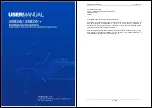
SmartVoice Gateway(s) User Guide
25
YML832 Rev1
NAT/DDNS (NAT Traversal)
If a gateway is set up behind an Internet sharing device, you can select either the NAT or STUN protocol.
•
N
AT Public IP:
The IP address used by the gateway should be a private address. Furthermore,
users must set the Virtual Server Mapping in the Internet sharing device (For example, a virtual
server is usually defined as a Service Port, and all requests to this port will be redirected to this
specified server’s private IP address).
The default ports of the gateway are listed below:
•
Listen Port (UDP):
5060
•
RTP Starting Port (UDP):
9000~9015 (Listen Port used for telephone communication).
•
Port of Web Access from WAN (TCP):
the number you specified in this option in Network
Settings page.
NOTE: You need to configure your Internet sharing device to forward the above
ports to the WAN IP address of the gateway.
•
NAT IP/Domain:
Enter the NAT Server IP address (real public IP address of the Internet sharing
device); or fill in a true URL (Uniform Resource Locator) when DDNS is used. Please refer to the
DDNS settings.
NOTE: If setting a public IP in this field, it has to be a static public IP, otherwise
VoIP communication may not be established properly. Please contact your ISP to
check whether your Internet connection has static public IP addresses.
•
Enable STUN Client:
Using the STUN protocol prevents problems with setting the IP sharing
function, but some NAT does not support this protocol.
NOTE: You can use the “Status - STUN Inquiry” page to detect type of NAT of your
Internet sharing device. If the NAT type is “Symmetric NAT”, then the gateway is
not able to traverse the NAT. It is not a flaw of the gateway design, but limitations
of the STUN protocol.
•
STUN Server IP/Domain and Port:
Enter the STUN server IP address and Listen Port number. You
can set 2 STUN servers separated by a semicolon.
•
Enable UPnP Control Point:
To enable the gateway’s IP traffic to pass through an Internet sharing
device. This function only works when the Internet sharing device supports UPnP and has it enabled.
NOTE: The “Status - Current Status” page will show the status of UPnP.
















































